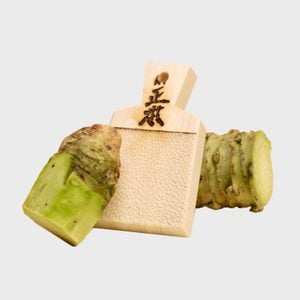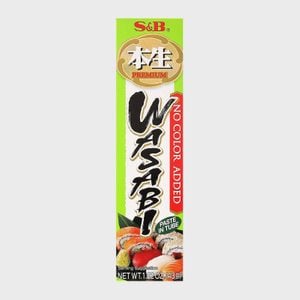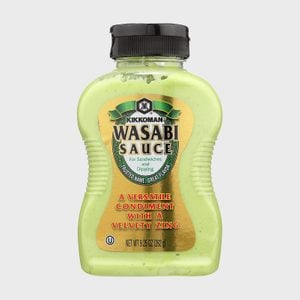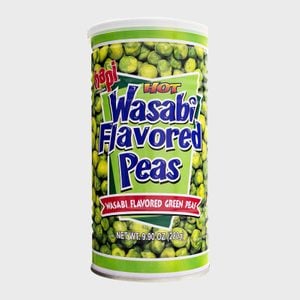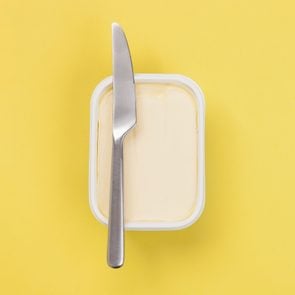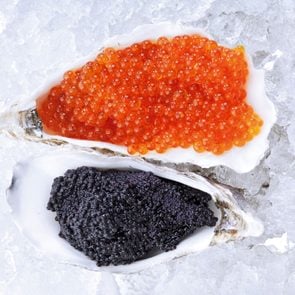What Is Wasabi, Exactly?
Updated: Feb. 02, 2023
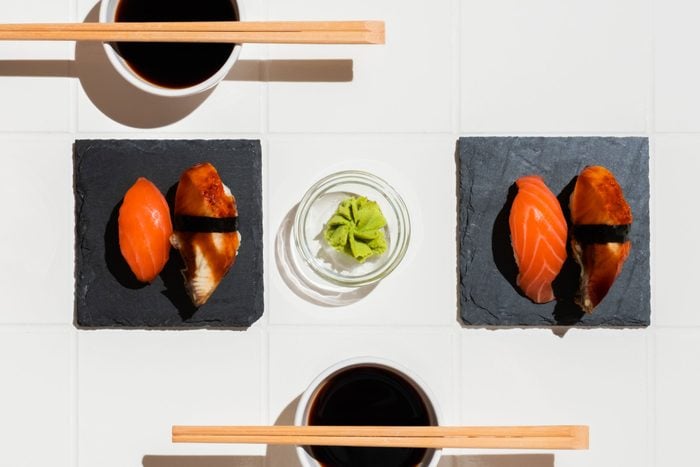
If you’ve ever wondered what’s actually in wasabi and why it’s so spicy, you’re in the right place.
If you eat a lot of sushi and sashimi, you’re probably pretty familiar with wasabi. What is wasabi, though, other than that dollop of green paste on the side of your plate? This Japanese staple actually has an interesting history that you may not be familiar with, and it’s one of our favorite bits of food facts trivia.
Native to Japan, wasabi dates back to approximately 700 AD and was originally used medicinally as an antibacterial. In the 1100s, however, warriors began using the roots of the wasabi plant as a garnish on sashimi, either to add flavor to the fish or protect against bacteria. While their reasons aren’t completely clear to modern scholars, the warriors’ new use of wasabi caught on and stuck.
And that brings us to the wasabi you eat today…sort of. The crazy thing is that you’ve probably never even had real wasabi, because it’s incredibly rare. So, what are you eating? Read on to find out. Then once you’re up to speed, find out about another flavor that’s also common in Asian cuisine: umami.
What is wasabi made of?
So what is wasabi, exactly? Real wasabi is made from the ground rhizomes (aka the stems) of the Brassicaceae mustard plant. The wasabi plant, called eutrema japonicum, is native only to Japan, though it’s been grown in smaller quantities in China, Korea, and the United States. It’s an expensive food because it’s limited, rare, and usually has to be imported. (FYI, this is similar to why saffron is so expensive.)
The interesting thing about real wasabi is that once it’s exposed to air, it starts to lose its pungence. For this reason, real wasabi is grated right before it’s served so that it has more spice to it. It’s also naturally green. Imitation wasabi, on the other hand, relies on food coloring to give it that verdant hue.
Why is wasabi so spicy?
If you’ve ever had wasabi, then you know it can be a tad spicy on the tongue…and that’s putting it mildly. This is because of the thioglucosides in it. According to UCLA’s Science and Food site, thioglucosides are “sugar glucose with sulfur-containing organic compounds.” When you grind the stems of the wasabi plant, the cells break down, releasing the thioglucosides. This is why real wasabi is grated right before serving.
The kick in wasabi is less heat and more sting, which is why some people who like food made with hot peppers don’t necessarily like wasabi. While wasabi always has the same flavor (provided it’s real wasabi), the level of spice can vary depending on when it was prepared. Since the plant’s spice starts to decrease as soon as it hits the air, wasabi that has been grated and prepared in advance will be less spicy than a freshly grated wasabi root. This is also why most wasabi found in stores is fake—it’s easier to preserve the spice level when the plant is not involved.
What does wasabi taste like?
It’s a bit tricky to liken the taste of wasabi to something else because it’s kind of in a class of its own, but it tastes fresh and spicy. Since the wasabi plant is part of the mustard family, it’s a bit similar to yellow mustard, though wasabi is a lot spicier. What’s interesting is that you’ll actually feel the spice through your nose almost more than you’ll feel it on your tongue. This is because much of the flavor and spiciness is released through fumes. When you eat it, you should feel its bite traveling through your nostrils and permeating your whole head.
That said, wasabi that isn’t true wasabi will taste more like horseradish, because that’s what it’s made from! Add to that some green coloring and voilà—you have the “wasabi” you’re probably used to.
What’s the right way to eat wasabi?
As mentioned earlier, wasabi traditionally has been eaten with sushi or sashimi to complement the flavor of the fish. More specifically, it can tamp down the fishiness of the fish, in addition to giving your palate a little kick. According to Nobu chef and founder Nobuyuki Matsuhisa, the best way to maximize your meal’s flavor is to dab a small amount directly onto your sushi and then lightly dip your sushi into soy sauce. So, if you’ve been mixing your wasabi in your soy sauce, that’s technically the “wrong” way to do it since it dilutes the flavor…but of course, it all boils down to personal preference, so you do you!
How can you tell real wasabi from fake wasabi?
It’s easy to tell the difference if you pay attention to your wasabi’s appearance and preparation. Fake wasabi paste looks like, well, a paste. Fresh wasabi tends to be grated on the spot, giving it a slightly looser appearance.
Most of the wasabi you’ve eaten is probably not real wasabi, considering how difficult it is to find the real stuff, and if you do, you’ll be paying quite a bit. Business Insider reports that real wasabi can run around $250 per kilo (a little over two pounds). And while you may never need that much wasabi, it’s not easy to find it in smaller amounts, and when you do, you might find yourself paying upwards of $50 for one rhizome. On the flip side, you can find fake wasabi products at your local grocery store for under $10.
Brian Oates, the president of Pacific Coast Wasabi, told the Washington Post in 2014 that roughly 99 percent of the restaurant wasabi in the United States is fake. He even said that much of the wasabi served in Japan—where wasabi grows—is also fake! And while this stat is a bit dated, the reasons that wasabi is so pricey have not changed.
Why is real wasabi so expensive?
The limited availability of the mustard plant required to make wasabi is responsible for the high price tag. Since these plants are found only in a handful of places, primarily in Japan, making wasabi in these regions and then transporting it worldwide is a pricey task. Another factor is how delicate the plants are. They need to be grown in cool, damp environments and can turn bad quite easily. It takes about three years, under very specific, attentive care, for the plants to mature. Once picked, the root is grated or ground into the wasabi on your plate.
Specialized Asian markets that carry rare foods may have real wasabi and most likely offer it as the actual root rather than in a container. If you’re not sure whether the wasabi you’ve found in a grocery store is the real deal or not, simply check the ingredients. Real wasabi contains only wasabi and nothing else, and it’s usually only sold as the actual plant or as a powder. Fake wasabi will have horseradish and mustard on the ingredient list. Some products have a blend of real and fake—wasabi with horseradish and mustard—which brings down the cost a little bit while still staying somewhat authentic. Wasabi sauce, which is a creamy wasabi-like condiment made with horseradish, oil, eggs, sugar, and corn starch, is even easier to find at the grocery store; though you can use it however you please, it’s often used with vegetables or noodles.
Next, find out all about bubble tea, from where it originated to what’s actually in it.
Sources:
- Brittanica: “Wasabi”
- Banjo: “History of wasabi”
- UCLA Science and Food: “Wasabi”
- Insider: “You’re probably eating sushi wrong — here’s the proper way, according to a world-famous sushi chef”
- Washington Post: “The wasabi sushi restaurants serve is pretty much never actual wasabi”
- McGill University: “Wasabi does more than simply add heat to sushi”
- Business Insider: “Why wasabi is so expensive”

